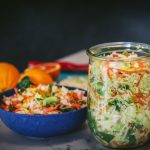Flu Prevention: Cultured Veggies
These cultured veggies are a little sweet and perfectly tangy! Not only do they taste amazing (because let’s be real, I’m a foodie, and it has to taste good! 😋), but they’re also packed with powerful benefits for your digestion, immune system, and adrenals.✨ Meet Your Gut's Best Friend: Lactobacillus plantarum! ✨L. plantarum is abundant in cultured veggies and has incredible anti-inflammatory properties. I’ve found it to be a game-changer when dealing with colds, the flu, or even pesky viruses. 🤧💪 This beneficial bacteria don’t stick around long, but while it's there, it fiercely attacks harmful pathogens and helps your native gut bacteria grow stronger—making you more resistant to future invaders. Your immune system LOVES this bacteria for good reason! 🛡️But wait . . . there's more! 🚀 This recipe is also loaded with prebiotics, meaning the good bacteria will thrive and multiply like crazy. The natural fibers in jicama, apples, oranges, garlic, and Prebio Plus act as super fuel, helping your probiotics flourish. 🌱✨This is more than just a probiotic-rich recipe—it’s a SUPERSTAR for your gut health, your immune system, and your taste buds. 🎉🥕 Try it, and you’ll see why I love it so much! 💛
Equipment
Ingredients
- ¼ teaspoon Veggie Starter Culture or ¼ cup Kefir Whey
- ½ small cabbage 6+ cups
- 1 cup jicama
- 1 cup apple
- 1 cup spinach or kale
- 1 small leek chopped
- 1 medium carrot shredded
- 1 clove garlic minced
- ½ tablespoon Celtic Sea Salt
- 1 large orange zested and juiced
- 1 scoop Prebio Plus optional
Instructions
- If using the starter culture, stir the culture into 1/4 cup of water. Let the mixture sit while you prepare the ingredients—around 10 minutes. If using kefir whey, add it when the recipe calls for culture.
- Finely shred the cabbage, jicama, apple, spinach, leek, and carrot using a food processor or a hand shredder. Add to a large bowl.
- Add the garlic, Prebio Plus, and salt to the bowl and toss to combine. Pack all ingredients into jars.
- Add the orange zest and juice, Cutting Edge Culture or kefir whey, and cover with water leaving an inch or two at the top.
- Seal the container and let it sit on your kitchen counter, out of direct sunlight, for 6 days. After 6 days, place the container in the refrigerator.
- Check the vegetables every day to make sure they are fully submerged in the water. If they have risen above the water, simply push them down so they are fully covered by the water. If any white spots formed because the veggies rose above the water, do not worry. Remember, this isn’t harmful. Just scoop out the vegetables that have the white spots on them and push the rest back under the water.
Video
Notes
Storage note: This kraut can be kept in a covered airtight jar in the refrigerator for up to nine months.
www.CulturedFoodLife.com
